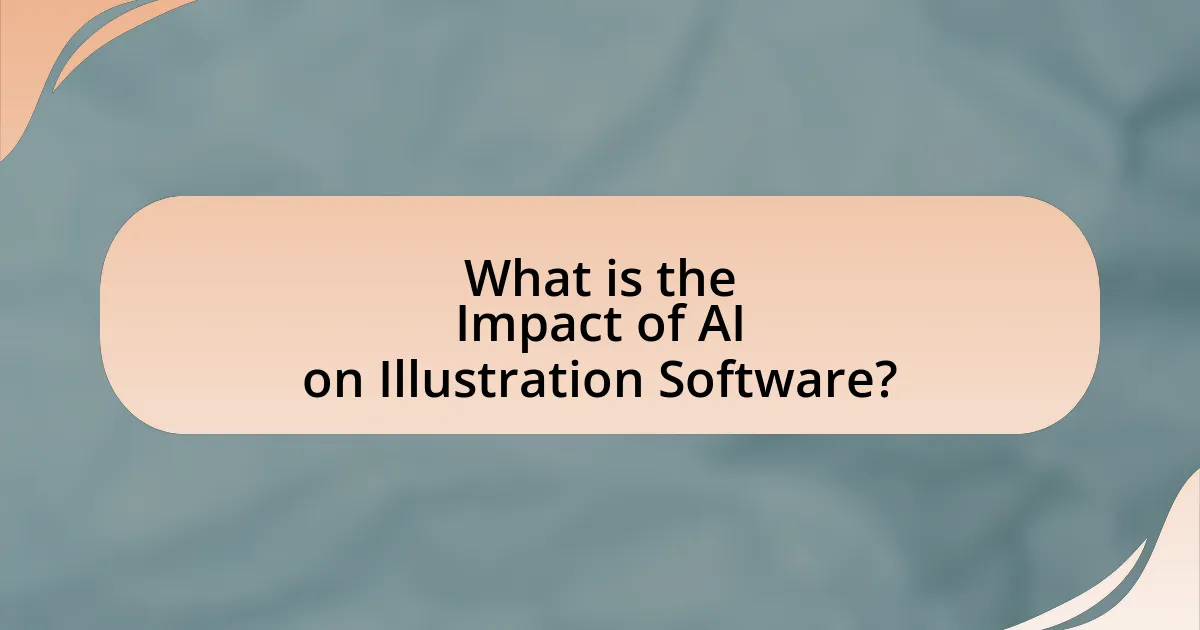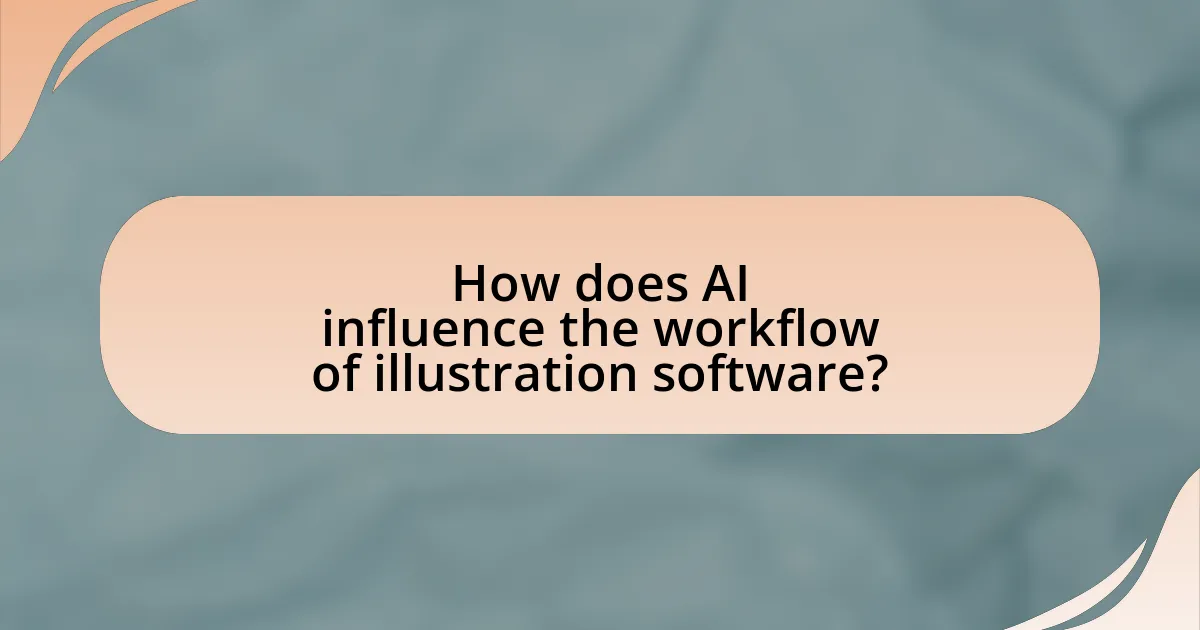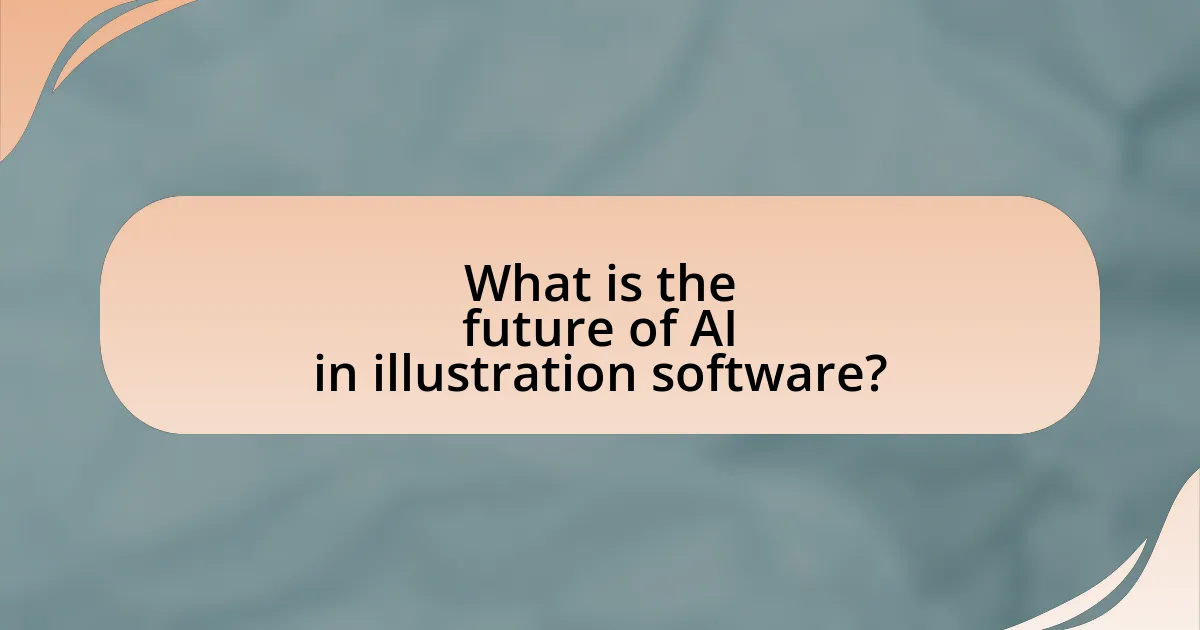The article examines the significant impact of artificial intelligence (AI) on illustration software, highlighting both the opportunities and challenges it presents for artists. Key advancements in AI, such as generative adversarial networks and machine learning algorithms, enhance creativity and streamline workflows by automating repetitive tasks and providing intelligent design suggestions. The integration of AI tools allows illustrators to explore new styles, improve productivity, and reach diverse markets, while also raising concerns about job displacement, creative control, and ethical implications. The article further discusses how illustrators can adapt to these technologies and maintain their unique artistic identity amidst the evolving landscape of digital illustration.

What is the Impact of AI on Illustration Software?
The impact of AI on illustration software is significant, as it enhances creativity, streamlines workflows, and automates repetitive tasks. AI algorithms can generate illustrations based on user inputs, allowing artists to explore new styles and concepts quickly. For instance, tools like Adobe’s Sensei utilize machine learning to suggest design elements and automate tedious processes, which increases efficiency. Additionally, a study by McKinsey & Company indicates that AI can reduce design time by up to 30%, demonstrating its effectiveness in improving productivity within the illustration field.
How has AI technology evolved in the context of illustration software?
AI technology has significantly evolved in illustration software by integrating advanced machine learning algorithms that enhance creativity and efficiency. Initially, illustration software relied on basic digital tools, but recent advancements have introduced features like automated image generation, style transfer, and intelligent editing capabilities. For instance, tools such as Adobe Fresco and Procreate now utilize AI to suggest color palettes and brush strokes based on user input, streamlining the creative process. Furthermore, AI-driven platforms like DALL-E and Midjourney can generate high-quality illustrations from textual descriptions, showcasing the transformative potential of AI in artistic workflows. This evolution reflects a broader trend where AI not only assists artists but also expands the possibilities of digital illustration, making it more accessible and innovative.
What are the key advancements in AI that influence illustration software?
Key advancements in AI that influence illustration software include generative adversarial networks (GANs), deep learning algorithms, and natural language processing (NLP). GANs enable the creation of high-quality images by training models to generate new visuals based on existing datasets, significantly enhancing the creative capabilities of illustration software. Deep learning algorithms improve image recognition and style transfer, allowing artists to apply various artistic styles to their work seamlessly. NLP advancements facilitate user interaction with illustration software through voice commands and text prompts, streamlining the creative process. These technologies collectively enhance efficiency, creativity, and user experience in illustration software.
How do these advancements change the way artists create illustrations?
Advancements in AI technology significantly change the way artists create illustrations by automating repetitive tasks and enhancing creative processes. These technologies allow artists to generate complex designs quickly, enabling them to focus more on conceptualization and creativity rather than technical execution. For instance, AI-driven tools can assist in color selection, composition, and even style transfer, which streamlines the workflow and increases productivity. Research from Adobe indicates that 70% of artists using AI tools report improved efficiency in their creative processes, demonstrating the tangible benefits of these advancements in illustration software.
What opportunities does AI present for illustrators?
AI presents illustrators with opportunities to enhance creativity, streamline workflows, and expand their market reach. By utilizing AI tools, illustrators can automate repetitive tasks such as coloring, shading, and background generation, allowing them to focus on more complex aspects of their work. For instance, AI-driven software like Adobe Fresco and Procreate leverages machine learning to suggest design elements and improve efficiency. Additionally, AI can analyze trends and consumer preferences, enabling illustrators to create more targeted and appealing artwork. This adaptability can lead to increased sales and collaborations, as AI tools facilitate the rapid production of high-quality illustrations tailored to specific audiences.
How can AI tools enhance creativity and efficiency for artists?
AI tools enhance creativity and efficiency for artists by automating repetitive tasks and providing innovative design suggestions. These tools, such as Adobe Sensei and Daz 3D, utilize machine learning algorithms to analyze artistic styles and generate unique content, allowing artists to explore new creative avenues. For instance, a study by the University of California, Berkeley, found that artists using AI-assisted software reported a 30% increase in productivity due to reduced time spent on mundane tasks. This combination of automation and inspiration enables artists to focus more on their creative vision while improving overall workflow efficiency.
What new markets or audiences can illustrators reach with AI?
Illustrators can reach new markets and audiences such as the gaming industry, personalized merchandise, and educational content creation through AI. The gaming industry increasingly demands unique and diverse artwork for character design and environments, which AI tools can help generate rapidly. Personalized merchandise, including custom illustrations for products like clothing and home decor, can be efficiently created using AI, appealing to consumers seeking unique items. Additionally, AI can assist in producing educational illustrations that cater to various learning styles, expanding the audience in educational publishing and e-learning platforms. These developments are supported by the growing integration of AI in creative workflows, as reported by industry analyses highlighting the increasing demand for customized visual content.
What challenges do illustrators face with the integration of AI?
Illustrators face several challenges with the integration of AI, primarily concerning job displacement, creative control, and ethical implications. Job displacement arises as AI tools can automate tasks traditionally performed by illustrators, potentially reducing demand for human artists. Creative control is challenged as AI-generated art may not align with an illustrator’s unique style or vision, leading to concerns about authenticity and artistic integrity. Ethical implications include issues related to copyright, as AI can generate works that closely resemble existing art, raising questions about ownership and originality. These challenges highlight the need for illustrators to adapt and find ways to coexist with AI technologies while maintaining their artistic identity.
How does AI impact the traditional skills of illustrators?
AI significantly alters the traditional skills of illustrators by automating repetitive tasks and enhancing creative processes. This technology allows illustrators to focus more on conceptualization and creativity rather than technical execution, as AI tools can generate backgrounds, color palettes, and even initial sketches. For instance, Adobe’s AI features in Photoshop and Illustrator streamline workflows, enabling artists to produce work more efficiently. Additionally, studies show that AI can assist in style transfer, allowing illustrators to experiment with various artistic styles quickly, thereby expanding their creative possibilities. However, this reliance on AI may lead to a devaluation of foundational skills, as emerging illustrators might prioritize learning AI tools over traditional techniques.
What ethical concerns arise from using AI in illustration?
The ethical concerns arising from using AI in illustration include issues of copyright infringement, bias in representation, and the potential devaluation of human creativity. Copyright infringement occurs when AI-generated illustrations replicate existing works without proper attribution or permission, leading to legal disputes. Bias in representation can manifest when AI systems are trained on datasets that lack diversity, resulting in illustrations that reinforce stereotypes or exclude certain groups. Additionally, the reliance on AI for creative tasks may devalue the skills of human illustrators, raising concerns about job displacement and the overall impact on the creative industry. These concerns highlight the need for ethical guidelines and regulations in the use of AI technologies in illustration.

How does AI influence the workflow of illustration software?
AI significantly enhances the workflow of illustration software by automating repetitive tasks and providing intelligent suggestions. This automation allows artists to focus more on creativity and less on technical execution, thereby increasing productivity. For instance, AI algorithms can analyze user patterns and generate design elements, which streamlines the creative process. Additionally, tools like Adobe Sensei utilize machine learning to improve image editing and enhance user experience by predicting user needs. These advancements lead to faster project completion times and improved overall quality of illustrations.
What are the main features of AI-driven illustration software?
AI-driven illustration software primarily features automated image generation, style transfer, and intelligent editing tools. Automated image generation allows users to create illustrations from text prompts, leveraging deep learning algorithms to produce unique visuals. Style transfer enables the application of artistic styles to images, allowing for creative customization. Intelligent editing tools provide functionalities such as object recognition, background removal, and color adjustments, streamlining the illustration process. These features enhance productivity and creativity, making illustration more accessible to a broader audience.
How do these features streamline the illustration process?
AI features streamline the illustration process by automating repetitive tasks and enhancing creative capabilities. For instance, AI algorithms can quickly generate variations of designs, allowing illustrators to explore multiple concepts in a fraction of the time it would take manually. Additionally, tools like automatic colorization and style transfer reduce the time spent on technical aspects, enabling artists to focus more on creativity. Research indicates that AI-driven tools can increase productivity by up to 50%, demonstrating their effectiveness in optimizing workflows within the illustration field.
What role does machine learning play in improving illustration tools?
Machine learning enhances illustration tools by automating repetitive tasks, improving user efficiency, and enabling advanced features like style transfer and predictive drawing. These capabilities allow artists to focus more on creativity rather than technical execution. For instance, Adobe’s Sensei uses machine learning algorithms to analyze user behavior and suggest design elements, streamlining the creative process. Additionally, tools like DeepArt utilize neural networks to apply artistic styles to images, showcasing how machine learning can transform standard illustrations into unique artworks. This integration of machine learning not only increases productivity but also expands the creative possibilities for illustrators.
How do illustrators adapt to AI technologies?
Illustrators adapt to AI technologies by integrating AI tools into their creative processes, enhancing efficiency and expanding their artistic capabilities. For instance, many illustrators utilize AI-driven software for tasks such as generating initial sketches, automating repetitive tasks, or enhancing color palettes, which allows them to focus more on the creative aspects of their work. A study by Adobe found that 70% of creative professionals believe AI will enhance their creativity rather than replace it, indicating a positive reception towards AI integration in the illustration field.
What skills should illustrators develop to work alongside AI?
Illustrators should develop skills in digital literacy, creativity, and adaptability to effectively work alongside AI. Digital literacy enables illustrators to understand and utilize AI tools, enhancing their workflow and efficiency. Creativity remains essential as it allows illustrators to produce unique concepts that AI cannot replicate. Adaptability is crucial for embracing new technologies and integrating AI into their artistic processes. According to a report by McKinsey, 60% of jobs will require digital skills by 2030, highlighting the importance of these competencies for illustrators in a rapidly evolving landscape.
How can artists maintain their unique style while using AI tools?
Artists can maintain their unique style while using AI tools by integrating their personal techniques and preferences into the AI-generated outputs. This can be achieved by customizing AI algorithms to reflect their artistic vision, selecting specific parameters that align with their style, and using AI as a collaborative tool rather than a replacement. For instance, artists can train AI models on their own artwork, ensuring that the generated content retains their distinctive elements. Research indicates that artists who actively engage with AI tools, rather than passively relying on them, are more likely to produce work that resonates with their individual style.

What is the future of AI in illustration software?
The future of AI in illustration software is characterized by enhanced automation, improved creativity tools, and personalized user experiences. AI technologies are increasingly being integrated into illustration software, enabling features such as automatic image generation, style transfer, and intelligent editing tools. For instance, Adobe’s Sensei AI platform has already begun to revolutionize creative workflows by automating repetitive tasks and providing smart suggestions, which significantly boosts productivity for artists. Additionally, a report by McKinsey & Company indicates that AI could increase productivity in creative industries by up to 40% by 2030, highlighting the transformative potential of AI in illustration software.
How might AI shape the next generation of illustration tools?
AI will significantly shape the next generation of illustration tools by enhancing creativity and efficiency through advanced algorithms and machine learning techniques. These technologies enable tools to automate repetitive tasks, suggest design elements, and generate unique styles based on user preferences. For instance, Adobe’s Sensei AI integrates machine learning to streamline workflows, allowing artists to focus on creative aspects rather than technical details. Additionally, AI-driven tools like DALL-E and Midjourney can create illustrations from textual descriptions, expanding the possibilities for artists and designers. This evolution not only increases productivity but also democratizes illustration by making it accessible to non-artists, thereby transforming the landscape of visual creativity.
What emerging trends should illustrators be aware of?
Illustrators should be aware of the increasing integration of artificial intelligence in illustration software, which is transforming the creative process. AI tools are enhancing efficiency by automating repetitive tasks, allowing illustrators to focus on more complex aspects of their work. For instance, software like Adobe Fresco and Procreate are incorporating AI features that assist in color matching and style transfer, streamlining workflows. Additionally, the rise of generative design tools enables illustrators to explore new creative possibilities by generating unique visual elements based on user inputs. This trend reflects a broader shift towards collaboration between human creativity and machine learning, which is reshaping the landscape of digital illustration.
How can illustrators prepare for future developments in AI technology?
Illustrators can prepare for future developments in AI technology by actively engaging in continuous learning and adapting their skills to incorporate AI tools into their workflow. This involves familiarizing themselves with emerging AI software that enhances creativity and efficiency, such as generative design tools and AI-assisted illustration platforms. Research indicates that 77% of creative professionals believe AI will significantly impact their work, highlighting the necessity for illustrators to embrace these technologies to remain competitive. By participating in workshops, online courses, and industry conferences focused on AI advancements, illustrators can stay informed about the latest trends and best practices, ensuring they leverage AI as a collaborative tool rather than viewing it as a threat to their artistry.
What best practices should illustrators follow when using AI tools?
Illustrators should prioritize ethical considerations, maintain creative control, and ensure proper attribution when using AI tools. Ethical considerations involve understanding the implications of AI-generated content, such as copyright issues and the potential for bias in AI algorithms. Maintaining creative control is essential, as illustrators should use AI as a tool to enhance their creativity rather than replace it, ensuring that their unique style and vision remain intact. Proper attribution is crucial when using AI-generated elements, as it acknowledges the contributions of both the technology and the original creators, fostering a respectful creative environment. These practices help illustrators navigate the evolving landscape of AI in illustration while upholding professional standards.
How can artists effectively integrate AI into their creative process?
Artists can effectively integrate AI into their creative process by utilizing AI tools for inspiration, automation, and enhancement of their work. For instance, AI algorithms can analyze vast datasets of existing art to generate new ideas or styles, allowing artists to explore innovative concepts that they may not have considered. Additionally, AI can automate repetitive tasks such as color correction or image resizing, freeing up artists to focus on more complex creative decisions. Research by the Massachusetts Institute of Technology (MIT) highlights that artists who adopt AI tools report increased productivity and creativity, demonstrating the tangible benefits of AI integration in artistic workflows.
What resources are available for illustrators to learn about AI technologies?
Illustrators can access various resources to learn about AI technologies, including online courses, webinars, and industry publications. Platforms like Coursera and Udemy offer courses specifically focused on AI applications in creative fields, while webinars hosted by organizations such as the Association of Illustrators provide insights from industry experts. Additionally, publications like “AI & Creativity” by the Creative AI Lab explore the intersection of AI and illustration, offering case studies and practical examples. These resources collectively equip illustrators with the knowledge to integrate AI into their workflows effectively.


